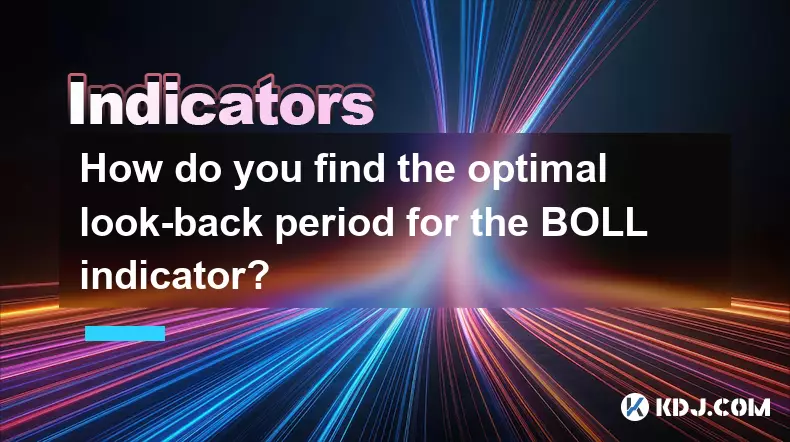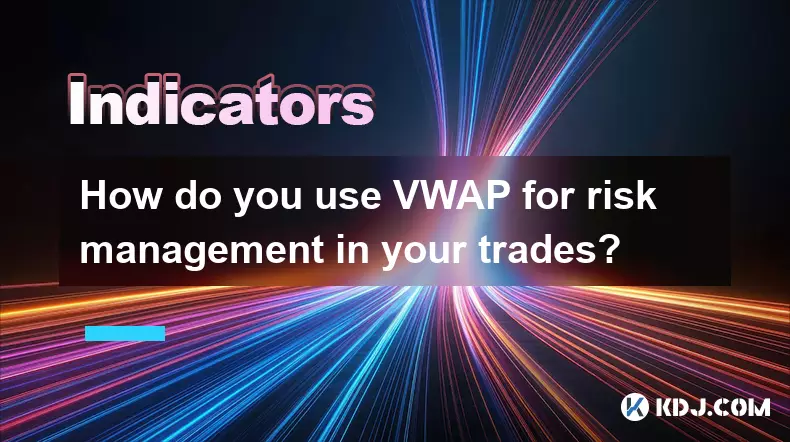-
 bitcoin
bitcoin $114684.631706 USD
-0.87% -
 ethereum
ethereum $4228.677447 USD
1.58% -
 bnb
bnb $1294.880693 USD
-1.16% -
 tether
tether $1.000819 USD
-0.02% -
 xrp
xrp $2.605138 USD
2.79% -
 solana
solana $209.908690 USD
5.89% -
 usd-coin
usd-coin $0.999903 USD
-0.03% -
 dogecoin
dogecoin $0.213423 USD
2.93% -
 tron
tron $0.322721 USD
-0.10% -
 cardano
cardano $0.727247 USD
3.66% -
 hyperliquid
hyperliquid $42.339456 USD
6.05% -
 chainlink
chainlink $19.910811 USD
5.16% -
 ethena-usde
ethena-usde $1.000557 USD
0.00% -
 stellar
stellar $0.349734 USD
2.69% -
 bitcoin-cash
bitcoin-cash $543.848687 USD
-0.21%
How do you find the optimal look-back period for the BOLL indicator?
Adjusting the BOLL indicator’s look-back period based on volatility, timeframe, and asset type can enhance signal accuracy in crypto trading.
Oct 11, 2025 at 07:00 am

Understanding the BOLL Indicator and Its Components
1. The Bollinger Bands (BOLL) indicator is a widely used technical analysis tool in cryptocurrency trading, designed to measure market volatility and identify potential price breakouts. It consists of three lines: the middle band, typically a 20-period simple moving average (SMA); the upper band, which is the SMA plus two standard deviations; and the lower band, the SMA minus two standard deviations.
2. The default look-back period for the BOLL indicator is usually set at 20 periods, commonly interpreted as days on daily charts. This value was originally chosen by John Bollinger based on empirical observations of market behavior and statistical norms.
3. However, in the fast-moving environment of the crypto markets, where sentiment shifts rapidly and volatility spikes are common, relying solely on the default setting may not yield optimal results across different assets or timeframes.
4. Adjusting the look-back period allows traders to fine-tune the sensitivity of the bands. A shorter period increases responsiveness to recent price changes but may generate more false signals due to noise. A longer period smooths out fluctuations but risks lagging behind sudden market moves.
5. The goal is to find a balance between reactivity and reliability—capturing meaningful volatility shifts without being misled by short-term anomalies that are frequent in digital asset markets.
Evaluating Market Volatility to Determine Look-Back Length
1. One effective method for optimizing the look-back period involves analyzing historical volatility patterns of a specific cryptocurrency. Assets like Bitcoin or Ethereum may exhibit different volatility profiles compared to smaller altcoins, necessitating customized settings.
2. Traders can calculate rolling standard deviation over various intervals (e.g., 7, 14, 25 periods) and compare how well each BOLL configuration aligns with observed price extremes. Periods where price consistently touches or breaches the bands may indicate an appropriate sensitivity level.
3. Using backtesting tools, traders can simulate performance across multiple look-back windows and assess metrics such as win rate, risk-adjusted returns, and frequency of false breakouts. For instance, testing 14 vs. 20 vs. 28-day periods on BTC/USDT daily data might reveal that a 14-period setting performs better during high-volatility bear markets.
4. Another approach involves measuring mean reversion tendencies. Cryptocurrencies often display mean-reverting behavior within certain ranges. By identifying the average cycle length of price oscillations using autocorrelation functions, one can estimate an ideal look-back that captures these cycles.
5. In low-volatility consolidation phases, longer look-back periods help filter out minor price wiggles. During high-volatility events like halvings or macroeconomic shocks, shorter periods adapt more quickly to expanding bands and breakout dynamics.
Adapting BOLL Settings Based on Timeframe and Trading Strategy
1. The optimal look-back period varies significantly depending on the chart timeframe. On 1-hour charts, a 12- to 16-period setting may be more effective than the traditional 20, given the compressed nature of intraday data and higher noise levels.
2. Scalpers operating on 5-minute or 15-minute charts might benefit from dynamic adjustments—using algorithms that recalculate the look-back based on real-time volatility indices such as the CVOL or proprietary on-chain metrics indicating investor stress.
3. Position traders focusing on weekly charts may extend the look-back to 30 or even 50 periods to capture broader structural trends and avoid premature signals from transient volatility bursts. This helps maintain alignment with long-term market regimes rather than reacting to short-lived panic or euphoria.
4. Integration with complementary indicators enhances accuracy. Combining BOLL width with RSI divergence or volume profile analysis allows traders to validate whether a squeeze or expansion corresponds to genuine momentum shifts.
5. Machine learning models trained on labeled datasets of past breakouts and reversals can automate the selection of optimal parameters. These models analyze thousands of combinations and output statistically validated look-back values tailored to specific coins and conditions.
Frequently Asked Questions
What role does standard deviation play in adjusting the BOLL look-back period?Standard deviation quantifies price dispersion around the moving average. When selecting a look-back period, traders must ensure it reflects the natural volatility of the asset. A mismatch—such as using a 20-period SMA on a highly erratic altcoin—can lead to bands that are either too narrow (causing constant touching) or too wide (missing early breakout signals). Aligning the period with the asset’s typical deviation pattern improves signal quality.
Can the same look-back period work across different cryptocurrencies?No single look-back period universally fits all digital assets. Bitcoin, with its relatively mature market structure, may respond well to a 20-period BOLL. In contrast, newer or lower-liquidity tokens often require shorter periods (e.g., 10–14) due to sharper, more erratic movements. Each coin demands individual calibration based on its unique trading behavior and volume characteristics.
How frequently should traders reassess their BOLL settings?Market regimes shift regularly in crypto due to regulatory news, protocol upgrades, or macroeconomic factors. Traders should review their BOLL configurations whenever there's a noticeable change in volatility, trend strength, or correlation with other markets. Quarterly evaluations or event-driven recalibrations help maintain relevance and effectiveness.
Disclaimer:info@kdj.com
The information provided is not trading advice. kdj.com does not assume any responsibility for any investments made based on the information provided in this article. Cryptocurrencies are highly volatile and it is highly recommended that you invest with caution after thorough research!
If you believe that the content used on this website infringes your copyright, please contact us immediately (info@kdj.com) and we will delete it promptly.
- XRP Price Prediction: Weekend Rollercoaster or Rally?
- 2025-10-12 08:45:16
- Bittensor (TAO): Super Bullish Signals Point to Potential 2x Rally
- 2025-10-11 10:25:12
- Silver Price Correction: Navigating the Dip & Identifying Key SEO Keywords
- 2025-10-11 10:25:12
- Decoding Crypto Trends: Bittensor's Bull Run, Cardano's Dip, and LivLive's Presale Buzz in 'Uptober 2025'
- 2025-10-12 08:45:16
- MoonBull: The Crypto Meme Coin Promising 1000x Gains?
- 2025-10-11 10:30:01
- Crypto Payroll Revolution: Stablecoins, Altcoins, and the Future of Salary Payments
- 2025-10-11 10:30:01
Related knowledge

What's the main difference between VWAP and TWAP?
Oct 12,2025 at 11:54am
Understanding VWAP and Its Role in Crypto Trading1. Volume Weighted Average Price (VWAP) is a trading benchmark that calculates the average price of a...

How do you identify exhaustion moves using VWAP and its bands?
Oct 12,2025 at 08:00am
Understanding the Role of Decentralized Exchanges in Crypto Trading1. Decentralized exchanges (DEXs) operate without a central authority, allowing use...

How do you use VWAP to scale in and out of positions?
Oct 14,2025 at 02:19am
Understanding VWAP as a Dynamic Benchmark1. The Volume Weighted Average Price (VWAP) is not just an indicator—it functions as a dynamic benchmark that...

What are the main advantages of using VWAP over EMA?
Oct 11,2025 at 02:18am
Main Advantages of Using VWAP Over EMA1. Volume-Weighted Average Price (VWAP) incorporates trading volume into its calculation, offering a more accura...

How do you use VWAP on different chart types like Heikin Ashi?
Oct 11,2025 at 05:01pm
Understanding VWAP in the Context of Heikin Ashi Charts1. The Volume Weighted Average Price (VWAP) is a powerful analytical tool commonly used by trad...

How do you use VWAP for risk management in your trades?
Oct 11,2025 at 02:54am
Understanding VWAP as a Dynamic Benchmark1. The Volume Weighted Average Price (VWAP) serves as a crucial reference point in intraday trading by reflec...

What's the main difference between VWAP and TWAP?
Oct 12,2025 at 11:54am
Understanding VWAP and Its Role in Crypto Trading1. Volume Weighted Average Price (VWAP) is a trading benchmark that calculates the average price of a...

How do you identify exhaustion moves using VWAP and its bands?
Oct 12,2025 at 08:00am
Understanding the Role of Decentralized Exchanges in Crypto Trading1. Decentralized exchanges (DEXs) operate without a central authority, allowing use...

How do you use VWAP to scale in and out of positions?
Oct 14,2025 at 02:19am
Understanding VWAP as a Dynamic Benchmark1. The Volume Weighted Average Price (VWAP) is not just an indicator—it functions as a dynamic benchmark that...

What are the main advantages of using VWAP over EMA?
Oct 11,2025 at 02:18am
Main Advantages of Using VWAP Over EMA1. Volume-Weighted Average Price (VWAP) incorporates trading volume into its calculation, offering a more accura...

How do you use VWAP on different chart types like Heikin Ashi?
Oct 11,2025 at 05:01pm
Understanding VWAP in the Context of Heikin Ashi Charts1. The Volume Weighted Average Price (VWAP) is a powerful analytical tool commonly used by trad...

How do you use VWAP for risk management in your trades?
Oct 11,2025 at 02:54am
Understanding VWAP as a Dynamic Benchmark1. The Volume Weighted Average Price (VWAP) serves as a crucial reference point in intraday trading by reflec...
See all articles










































































